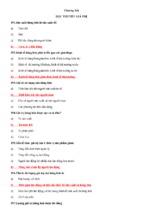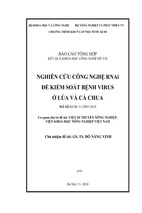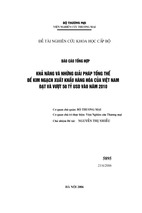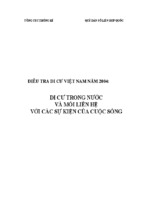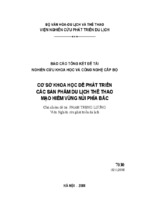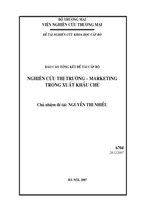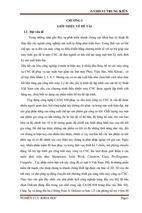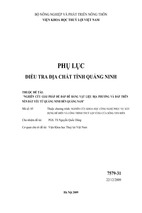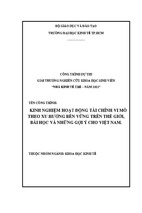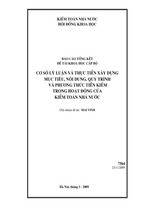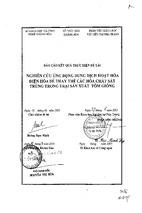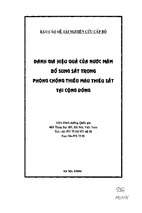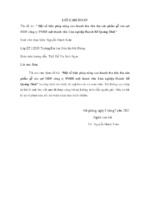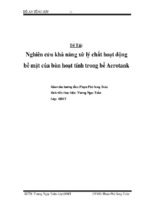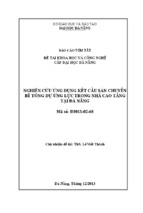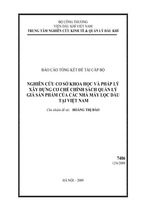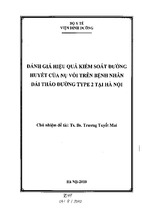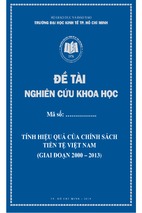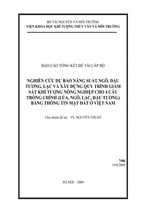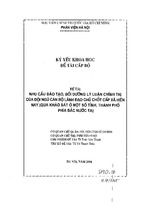EARLY CHILDHOOD ASSESSMENT
FOR CHILDREN FROM
BIRTH TO AGE 8 (Grade 3)
December 2005
Early Learning Standards Task Force
and Kindergarten Assessment Work Group
Pennsylvania BUILD Initiative
Pennsylvania’s Departments of Education and Public Welfare
Harrisburg, PA
EARLY CHILDHOOD ASSESSMENT FOR CHILDREN
FROM BIRTH TO AGE 8 (Grade 3)
I.
Introduction
5
II.
Measuring Children’s Development and Learning
6
III.
Curriculum
15
IV.
Linking Assessment And Curriculum
17
V.
Conclusion
18
VI.
Resources For Measuring Classroom Environments
18
VII.
References
20
VIII.
Assessment Tools
24
IX.
Curriculum Resources
35
X.
Workgroup Members
36
XI.
Definitions
37
3
Pennsylvania Standards for Learning – Assessment & Curriculum – December, 2005
4
Pennsylvania Standards for Learning – Assessment & Curriculum – December, 2005
EARLY CHILDHOOD ASSESSMENT FOR CHILDREN
FROM BIRTH TO AGE 8 (Grade 3)
I. INTRODUCTION
Developmental assessments are a process which allows one to understand a
child’s competencies and to design learning environments which will help a child
grow to his or her developmental potential whether this is from birth to age 8 or
third grade. Assessments that are implemented in the classroom and aligned with
Pennsylvania’s standards for learning (birth to age 8 or third grade) will help
inform teachers about designing a curriculum that provides multiple learning
opportunities that best suits how each child learns.
A two step process occurred to provide guidance to early childhood programs and
school districts for the alignment of assessment and curriculum to the
Pennsylvania standards for learning for children birth to age 8. First, a workgroup
consistently mostly of members of the original Early Learning Standards
Taskforce was formed. This workgroup developed a report, Final Report and
Guidelines on Assessment and Curriculum (2005) to address the linkages of
assessment and curriculum that would assist in the adherence to the Early
Learning Standards for Pre-Kindergarten children. An important workgroup goal
was to help make program personnel aware of available materials that encourage
teachers to rely on authentic measures of early learning and development that link
directly to program content and goals, as well as Pennsylvania’s standards for
learning, and that sample skills in natural, active learning environments, rather
than contrived circumstances.
The second step in the process to provide guidance for Pennsylvania’s standards
for learning was to convene a second work group comprised of individuals from
the Pennsylvania Department of Education, school districts, universities, early
childhood, and early intervention to examine the original document developed by
the Early Learning Standards Taskforce. The intent of the meeting was to
examine the report and to determine how to modify it so that the report
emphasized that assessment and curriculum are part of a continuum that begins at
birth and extends through Kindergarten to third grade. The information provided
in this document incorporates information from the original report and it also
emphasizes the importance of viewing assessment and curriculum development as
a continuous process from birth to age 8. Therefore, the current assessment
guidance document meets the needs of both the Early Learning Standards and the
Kindergarten Standards.
This report offers information about the extent to which several assessment tools
and curriculum materials align with Pennsylvania’s standards for learning (birth
to age 8). It is not the Department of Education’s intention to make specific
recommendations with regard to the items on the lists provided herein (see Tables
5
Pennsylvania Standards for Learning – Assessment & Curriculum – December, 2005
1-3), rather, the Department wishes to provide guidelines for decision making that
would best adhere to the Pennsylvania standards for learning (birth to age 8).
Given the many resources available on the market, both workgroups limited the
list of assessment tools to those that are evidence-based and have demonstrated
technological adequacy for the preschool and elementary school age groups.
The list of assessment tools also focuses specifically on assessment for the
purpose of informing instruction; thus, the measures are all appropriate and
feasible for administration by teachers and other classroom personnel. It is
important to realize that there are many purposes of assessment, such as for
diagnostic purposes, for program evaluation, for determining school readiness,
and for screening developmental delays or learning difficulties. These other
purposes are not as relevant for adhering to the Pennsylvania standards for
learning (birth to age 8) and so the focus of this report is on using assessment to
inform instruction.
Summary of Tables: There is a brief overview of critical features (see Tables 1
through 3) for each instrument. These tables are appropriate for both the Early
Learning Standards and the Kindergarten standards and the instruments are
marked accordingly. Next, we offer an overview of the coverage (i.e., alignment)
of the Key Learning Areas of the Early Learning Standards for Pre-Kindergarten
for each of the measures (see Tables 4 and 5). Blank cells in the table represent
the Key Learning Areas that are not covered by that instrument. An “X” indicates
that there is at least minimal coverage of that key learning area. An overview for
the Kindergarten Standards will be added in the future. For more specific details
within each of the Key Learning Areas, one needs to refer to the extensive
matrices in which items from each of the instruments are correlated with the
Standards at the Indicator level. Table 6 provides an overview of the coverage of
curriculum materials for each of the Key Learning Areas in the Early Learning
Standards. Curriculum materials are currently under review for the Kindergarten
standards and will be added in the future.
II. MEASURING CHILDREN’S DEVELOPMENT AND LEARNING
Background
The overall purpose of assessment, regardless of age, is to help teachers
make appropriate instructional decisions about how to best teach children. The
principles and philosophy of assessment that we often apply to young children are
part of a continuum that begins at birth and extends through Kindergarten to third
grade. Measurement, both assessment and evaluation, of the skills learned by
young children must rely upon practices that fit expected learning skills and
behavior and then change, as appropriate, to support children as they grow and
develop. For example, young children learn and exhibit their learning in different
ways than older children. Young children learn by doing rather than just listening
and may best exhibit what they know in actions rather than in speech or writing.
6
Pennsylvania Standards for Learning – Assessment & Curriculum – December, 2005
Because growth is more rapid in the period from birth to age eight then at other
periods of development it becomes challenging to capture children’s skills and
abilities, particularly at any one point in time (Zaslow, Calkins, & Halle, 2000).
The varying developmental changes make the needs for assessment of young
children very different from those for older children or adults. In many instances,
professionals both teach and test young children using downward extensions of
methods used with older individuals, often to the detriment of children. Too
often, childhood testing results in the “mismeasure” of young children.
Assessment methods of children need to support children's developmental
changes along a continuum to gather reliable data (Zaslow, Calkins, & Halle,
2000; Neisworth & Bagnato, 2004).
A common reaction from the field with regard to assessment is nervousness about
the inappropriateness of “testing” children and fear about high-stakes decisionmaking. Certainly, the use of assessment tools that are inappropriate for children
should be avoided, whether they are in preschool or of elementary school-age.
Early childhood assessment should never be high-stakes. However, the benefits
of assessment procedures for children birth to age 8 need to be more widely
recognized. Integrating assessment with curriculum and standards offers an
opportunity to elevate the level of professionalism in the field of early education
(birth to age 8), similar to that of other more evidence-based fields.
Recommended practices in assessment of young children (birth to age 8) are
guided by specific professional standards and position statements established by
major national organizations, including the National Association for the
Education of Young Children (NAEYC); Division for Early Childhood (DEC) of
the Council for Exceptional Children; the Head Start Program Performance
Standards; American Educational Research Association (AERA); and the
National Association for School Psychologists. These practices have been set and
revised regularly through a rigorous process of social validation by experts and
practitioners in the fields. Many of the standards have a research evidence base
(Dunst, Trivette, & Bagnato, 2001). Generally, the position statements and
guidance reflect the concepts that assessment of young children (birth to age 8) is
appropriate, beneficial, and useful, if used as intended.
Measurement Considerations
Several principles exist that are important when measuring the development and
learning of children birth to age 8 or third grade. These principles direct
programs in determining which assessment instrument best meets the needs of the
children, as well as the needs of the program (both early childhood and schoolage).
1. Purpose: Assessment results can identify both the well-developed and least
well-developed skills of children so that beneficial learning experiences and
teaching can be individually planned and carried out. Assessment on children
7
Pennsylvania Standards for Learning – Assessment & Curriculum – December, 2005
birth to age 8 years is not conducted primarily for diagnostic purposes, that is,
to determine whether the child has comparative deficits or delays in reference
to peers his/her age. Rather, assessment of children presumes that assessment
provides the information needed to plan programs and curriculum that will
promote each child’s progress. Assessments are conducted to:
Find out what children are interested in,
Find out children’s strengths and areas of difficulty,
Make informed decisions about interventions,
Discover how children change over time,
Learn what children know in particular areas, such as reading,
Link with instruction, making sure instruction is responsive and
appropriate, matching what children can and cannot do, and
o Serve as a basis to report to parents.
o
o
o
o
o
o
Assessment is NOT conducted to classify the child’s “readiness” for inclusion
in an educational setting and assessment is DEFINITELY NOT conducted to
exclude the child from preschool or Kindergarten because of an erroneously
presumed lack of readiness. It IS conducted to plan beneficial opportunities
for each child.
Many different purposes exist for assessment so instruments are usually
designed to address only one specific purpose. Potential misuses of testing
with children may occur when measures intended for one purpose are used
inappropriately for other purposes (Hirsh-Pasek, Kochanoff, Newcombe & de
Villiers, 2005). An example of this is to use results from a screening test to
determine the cause of a child’s developmental delay. A diagnostic tool is
more appropriate for this purpose.
Keep in mind that the focus of this report’s guidelines is on the process of
assessment for the purpose of informing teaching. The measures reviewed
here are limited to those most appropriate for this purpose. Teaching and
learning are reciprocal processes that influence each other and only through
assessment can it be determined how well the teacher is teaching and how
well the student/child is learning (Kellough & Kellough, 1999). Recently,
assessments, particularly in elementary school, have focused on determining a
child’s achievement level, rather than to “identify” a child’s intervention
needs or to ascertain appropriate instructional strategies.
One particular purpose of assessment often causes confusion and this is the
use of screening instruments or “screeners.” The criteria for developmental
screening instruments are generically defined by the characteristic of being
brief, cursory, objectively scored, reliable, and valid (Meisels, with AtkinsBurnett, 1994). Brief instruments, for reasons of feasibility, are often used
when large groups of children need to be evaluated. The results generated
from this type of procedure tend to be used for purposes that are beyond the
8
Pennsylvania Standards for Learning – Assessment & Curriculum – December, 2005
classroom level or for informing teaching. Although it may be useful to
teachers to view and be aware of results from a screening procedure, most
commonly, results are used by schools/programs in order to identify those few
children who may need to receive more extensive (diagnostic) assessment for
determining developmental delays or special needs. A screener, though brief,
is usually effective in catching the most severe cases of children who would
need follow-up evaluation.
More recently, screening instruments are used to assess whether a child is
developmentally ready to attend an educational program or to determine a
child’s school readiness. Screeners are often inappropriately used as
readiness tests for children. School districts are not permitted to deny
children entry to Kindergarten based on the results of a readiness test.
However, the assessment results from pre-Kindergarten settings are important
because the information can inform Kindergarten teachers about children’s
developmental status. This information, in conjunction with assessment
results conducted near the beginning of the Kindergarten school-year, can aid
in the development of a plan that best suits each child. A supportive
transition between preschool and Kindergarten will occur when childcare
teachers understand and have knowledge of the Pennsylvania standards for
learning and communicate with school district teachers, and equally, school
district teachers understand children’s early learning environments, what they
have already learned, and what kinds of supports the children have received.
Assessing children as they enter Kindergarten is particularly important to help
determine the child’s areas of strengths and needs so the teacher can adapt the
learning environment and activities to the needs of all the children in the
classroom. “When [assessment] information is used by the classroom teacher
to design the child’s learning environment, [the child’s] success in school is
enhanced, and a more stimulating, exciting learning environment is facilitated
(Niemeyer & Scott-Little, 2001, p 2). However, the measures often used at
the start of Kindergarten are usually too brief to be appropriate for evaluating
children’s status and ongoing progress in a way that informs instructional
planning that will align with Pennsylvania’s standards for learning (birth to
age 8).
2. Method: The ideal method of assessing children is through authentic,
naturalistic observations that occur on an ongoing basis. The observations
should occur during daily activities, teaching, and care routines to describe the
development and learning of children. The assessment is not a one-time event
since it is difficult to gather valid and reliable indicators of development from
this type of information (NAEYC/NAECS/SDE, 2003). Methods of engaging
in ongoing assessment include portfolios, observations, anecdotal notes, and
checklists, to name a few.
As children move into Kindergarten and the early grades of elementary school
these types of assessments become more difficult to implement, but are not
9
Pennsylvania Standards for Learning – Assessment & Curriculum – December, 2005
impossible. More norm-referenced testing, or testing to get a score, becomes
more common place as children become older because of the need to assess
large groups of children more quickly and to produce a score that can indicate
progress or lack thereof. As children progress through the grades, there are
fewer opportunities to engage in ongoing, authentic assessments. Classrooms
become more structured and there is an increased focus on instruction and
content. Overall, there are fewer authentic-based instruments available for the
older age group. However, research has demonstrated that elementary school
children enrolled in classrooms that use a curriculum-embedded assessment
instrument showed greater gains in reading on a conventional test of academic
accountability than those students who were not in such classrooms (Meisels,
Atkins-Burnett, Xue, Bickel, Son, 2003).
To provide a little background information on types of assessment, there are
generally two types of assessment: formal and informal. Formal assessments
are defined as highly valid and reliable (.8 or above), standardized
(administered similarly each time), and have standards of comparison (normreferenced, standards referenced, and criterion-referenced) to make sense of
the results (see definitions). These instruments are usually published by a
national company. Informal assessments, on the other hand, do not follow
standard conditions or use standard materials, they often do not have
documented reliability (.5 to .6 are acceptable) and validity, and they may be
published, but they can also be teacher or program developed (i.e., classroom
checklist). Ongoing, authentic assessments tend to fall under the definition of
informal assessments and are usually considered to be criterion-referenced
(the comparison is based on a students’ own knowledge and skill rather than a
norm group).
For a comprehensive explanation of the terms related to methods of
assessment, please see the “definition” section in the back of this report.
3.
Context: As stated above under Method, the best way to assess children is
through naturalistic observations of children on an on-going basis. Evidence
of children’s developmental abilities comes from ongoing structured
observations of naturally occurring behavior in natural, everyday settings and
routines (home, preschool, community) by teachers and other caregivers
(parents, psychologists, aides, and other team members). Structured
observation schedules and ratings formats, as well as other teachable moments
and informal interactions with the child, enable educators to capture real-life
examples of each child’s problem-solving, language, literacy, math, motor,
social, and self-skills. Measures which sample real-life behavior in real-life
settings are called authentic assessment measures. These types of measures
can examine the whole child in their natural learning environment.
“Table-top testing” and/or “pencil-and-paper standardized tests” are
discouraged for children birth to age 8 for a variety of reasons. For example,
10
Pennsylvania Standards for Learning – Assessment & Curriculum – December, 2005
young children and children in Kindergarten may not be able to use a pencil
effectively to demonstrate their knowledge. A test of this type does not
capture some of the skills that are critical to success in school (i.e., social and
emotional development; approaches to learning) (Scott-Little & Niemeyer,
2001). As children grow older and their skills broaden they are better able to
demonstrate their knowledge and skill. Again, assessment of children follows
a continuum similar to children’s developmental changes. Younger children
need naturalistic opportunities to demonstrate their skills while this need
begins to change as children grow older where they can more easily
demonstrate their knowledge in a traditional test format. However, the more
natural the setting for assessment the more likely a thorough and accurate
assessment of children’s skills and abilities will occur.
4. Process: Caregivers and/or teachers are committed to compiling ongoing
observation data for every child several times (at least 3 times) each year
during his/her education. Assessment is not a one-time event; rather, it is
conducted serially over time to document progress and growth during the
child’s participation in high-quality care and education programs, including
both preschool and elementary school. It is not primarily comparative, but
rather individualized so that each child’s previous performance is viewed as
the reference point to make individual comparisons about progress and gains
due to the program and/or curriculum being implemented (i.e., criterionreferenced). Ongoing, authentic assessments become more challenging as
children enter elementary school, but they are not impossible. Anecdotal
notes and record-keeping, whether this is documented through mastery tasks;
checklists, questionnaires, and rating scales; portfolios; and observations are a
sure-fire method of documenting children’s progress and learning of the
curriculum. It is best not to use “one shot” assessment information to modify
the curriculum because children can changes so dramatically through the
school-year.
5. Standards-based: Best practice emphasizes that assessment is NOT
conducted separate from the child’s program and/or curriculum. Assessment
is an integral part of each child’s educational program and it drives the
curriculum and instruction that is developed. Early childhood assessment
(birth to age 8 or third grade) has content that links or aligns with the
Pennsylvania standards for learning and the best practices of the professional
organizations (e.g., NAEYC, DEC, Head Start). Measures which are
authentic and sample content contained in the standards or the program are
called curriculum-consistent measures.
6. Parents as Partners: One critical part of assessment is the role of the parent.
To fully understand a child’s development a family-centered focus is
important (National Association of School Psychologists, 2005). Parents and
educators should work together as a team. Parents witness their children’s
functioning and behavior in a wide variety of contexts, and their input is
11
Pennsylvania Standards for Learning – Assessment & Curriculum – December, 2005
valued as part of the child’s overall assessment. Many parents lack an
understanding of the processes of assessment and what is expected and
appropriate. An emphasis should be placed on explaining the importance of
ongoing assessment to parents and how their role is critical to the process.
Families need to understand how their child is being assessed and what the
findings mean to them and to their child. The more that parents are included
in the assessment process the greater their ability to make fully-informed
decisions in addition to the likelihood of their cooperation with the education
planning for their child.
Summary
There are a number of guiding principles for assessment that are summarized
in the following bullets (Scott-Little, 2001; Scott-Little & Niemeyer, 2001;
NAEYC & NAECS/SDE, 2003):
o Ethical principles guide assessment practices,
o Assessments benefit all children,
o Assessment instruments are used for their intended purpose
and the purpose is clear,
o Assessment is ongoing and regular throughout the school year,
o Assessments are sensitive to cultural and language differences,
o Instruments are age appropriate (sufficiently measures above
and below age targeted),
o A range of indicators is assessed,
o Multiple sources and types of information are used,
o Evidence is gathered from realistic settings and situations that
reflect children's actual performance, and
o Instruments are reliable and valid.
Three Types of Measures
The measures profiled in tables 1 through 3 included in this report were chosen
based on their technical qualities and their match with the above philosophy about
developmentally-appropriate early childhood assessment for children birth to age
8 (third grade). Three types of measures are profiled in 3 separate tables and there
is a column that distinguishes if the instrument is appropriate for the Early
Learning or Kindergarten Standards:
• Authentic Curriculum-based Measures: These measures are best used
by teachers, professionals, and other caregivers in the early childhood
program or elementary schools. They best fulfill the philosophy of
professional organizations and best match the content of most curricula
and Pennsylvania’s standards for learning.
•
Specific Early Learning Skills Measures: These measures provide
more in depth probes into specific skill areas including literacy, math,
language, and other pre-academic competencies and are to be used in
12
Pennsylvania Standards for Learning – Assessment & Curriculum – December, 2005
cases when more in-depth understanding of a particular area of
development is needed. Assessment using these measures does not need
to be conducted if the authentic curriculum-based measures used
adequately cover the domains of interest. There are many in-depth singledomain instruments; the guidelines provided here are limited to those
instruments that can easily be used by classroom personnel.
•
Disability-Sensitive Measures: These measures accommodate best the
various sensory-motor, language, cognitive, social-behavioral, and
cultural needs of children with developmental disabilities. The
instruments in this third category are also appropriate for use by teacher or
classroom personnel and can be used before, and independent of, a formal
referral process that may take place regarding special education services.
Steps to Conduct Assessment
Supervisory support for assessment by program administrators is critical to
maintain ethical standards, recommended practices, as well as the reliability and
validity of the instrument being used. Assessment instruments and methods
change as children develop from birth to age 8 or third grade. In the early years,
authentic measures are emphasized because of the developmental capabilities of
the children. As children enter elementary school in Kindergarten, authentic
assessment methods begin to decrease because there are fewer opportunities to
engage in this type of assessment and more formal assessments increase as
children gain the developmental skills necessary to demonstrate their knowledge.
Please note that conducting authentic, curriculum-consistent assessments will
provide the richest information about the whole child. The following steps
present the ideal assessment process. However, implementing any of the steps is
a plus for any education program working with children birth to age 8.
1.
Use only authentic curriculum-based scales to the greatest extent possible as
the first stage in evaluating the early learning skills of children while they
are participating in the educational settings.
2.
Compile ongoing observation data for every child at least 2 times
(preferably 3 times) per year, for example, September and May or
September, January, and May to document the child’s progress over time.
The frequency of monitoring is dependent on the progress the child is
making.
3.
Gather information from teachers, aides, parents, and other caregivers who
know the child well and observe daily children’s naturally occurring
thinking, language, social, motor, and self-control skills.
4.
Watch, observe, and record each child’s strong and weak skills through
daily/weekly observations.
13
Pennsylvania Standards for Learning – Assessment & Curriculum – December, 2005
5.
Use a specific measure of early learning skills to probe further into areas
that may require more in depth evaluation such as early literacy, reading,
math, and general knowledge.
6.
For children with developmental disabilities, use only measures that have
been designed and field-validated for use with children having specific
needs as the primary measurement tool.
7.
Collect information on all children individually and as classroom groups to
note changes overtime.
8.
Incorporate information collected into teaching strategies, classroom
activities and curricula materials at each time-point. Constructing the
environment to encourage particular activities is an appropriate method of
collecting data.
9.
Use the information collected over time as records of the performance and
progress of children to share with parents and for transition building with
principals, the teacher’s of the following school year (i.e., kindergarten
teachers or first grade teachers), and others.
Teachers and other professionals are obligated to write reports that are
understandable and useful to families. Many families have little background
understanding of assessment information or may have low-literacy skills and
these issues should be kept in mind when the report is being written. Families
need adequate time to review reports, ask questions or express concerns before
any information about the child is used for decision-making.
Culture and Language Fairness in Assessment
Children from minority groups can vary from mainstream American children in
many ways. For example, ethnically diverse children differ in their styles of
interaction, such as speaking only when one is spoken too, being more passive
participants and preferring more cooperative learning than competitiveness with
other children. They have difficulties with the way information is conveyed in
group situations compared to their interactions in the home. Further, children
with limited English proficiency are unable to process information in the
classroom and can become inattentive and distractible. These types of differences
could be mistaken for lack of motivation, lack of school readiness, or even
developmental delay. Indeed, children from culturally and linguistically different
backgrounds are over-identified as mentally retarded and their ability to learn is
too often underestimated.
It is necessary to determine skill and fluency in the language or combination of
languages that a child uses. Difficulty in communication can be due to limited
14
Pennsylvania Standards for Learning – Assessment & Curriculum – December, 2005
English skills, the process of second language acquisition, or a communication
disorder. Assessing children’s non-English language competency is important
because age-appropriate skills in the child’s home language would eliminate
concern for a communication disorder.
Authentic assessment methods are advocated for all children; however, this is
especially important for children whose culture and language are different from
the mainstream. Dynamic and active learning measures are preferred to
standardized measures which could decrease assessment bias against minority
children. These assessments are usually conducted in comfortable, familiar
settings that are of interest to the child and rely far less on children’s language
abilities compared to most conventional tests. Again, authentic assessments are
achievable in elementary grades, and may be of particular importance to
ethnically diverse children to ascertain their developmental difficulties. Although
these children will have to participate in the more standardized assessments
expected in many school districts, the supplement of authentic observational
methods is ideal.
III. CURRICULUM
Background
Curricula for children birth to age 8 fall along a continuum where learning
activities change with the developmental needs of the child. In the early learning
years, there is more use of concrete materials and hands-on activities than of the
more structured curriculum experiences in first through third grade, and to a lesser
extent, Kindergarten. Because what young children are capable of learning and
doing is so dependent on their development, instructional decisions must take into
account each individual’s developmental level or placement along the continuum.
The instructional strategies also must take into account how to keep the child
moving along the continuum of learning and development during the school year.
Further, in addition to being developmentally appropriate, the curriculum needs to
be research-based and culturally and linguistically responsive, supporting
educational equity for children who are learning English or who are from minority
backgrounds.
With regard to a specific definition, the curriculum for children birth to age 8
should be research-based, multi-dimensional, and include more than one
prepackaged product available through a publisher. No one commercial program
will be able to address the needs of all learners. Any published program and
materials are merely tools that help teachers do their teaching. The Pennsylvania
standards for learning (birth to age 8) are the guide for teacher’s day to day
teaching.
The curriculum includes content, methods of implementation (i.e., teaching
strategies, schedule, materials), alignment with the Pennsylvania standards for
15
Pennsylvania Standards for Learning – Assessment & Curriculum – December, 2005
learning (birth to age 8), appropriate environments, individual assessment results,
all developmental domains, and parent involvement. A curriculum defines the
scope and sequence of what is taught with goals in each content area. All
materials should be selected in view of how they will support the curriculum.
Children with special needs follow an Individualized Educational Program (IEP),
which has individual goals, schedules for assessment, and adaptations that include
materials and strategies that may not necessarily be tied to the curriculum, but can
be implemented within the curriculum.
Children require both a foundation of factual knowledge and skills, as well as a
conceptual understanding that allows facts to become “usable” knowledge
(National Research Council, 2001, p.185). Ideally, the goals and framework of a
curriculum that is linked to standards will lead to a coherent set of activities and
teaching practices that build this foundation for learning. Teachers need to decide
how activities can fit together to benefit children’s growth and development, as
well as how to modify activities so that they are part of a continuum that is
responsive to children's development.
Appropriate curriculum promotes a balance between planned experiences that
help children progress toward defined goals, the experiences that emerge from
children’s interests, and unexpected events that are “incorporated into the
program in ways that comply with standards and curriculum goals” (NAEYC &
NAECSSDE, 2003, p. 8). Many teaching strategies are effective for achieving
this balance. Both instructional teaching and child-initiated instruction, teaching
through play, teaching through structured activities, engagement with older peers
and with computers, are all effective methods of instruction (National Research
Council, 2001, p. 231). In addition, balancing different types of instruction,
including individual and group instruction such as large, small, flexible, and
whole groupings are important methods of teaching. These strategies are tools
which serve different ends; thus, it is important to recognize that none can be
expected to be most effective for all purposes.
Developing or selecting a curriculum and curriculum materials is only the first
step, however. The effectiveness of any curriculum will depend on its
implementation. Once a particular curriculum is adopted, it should be tracked to
see whether it is being implemented as intended and aligned with best practice in
early childhood education (birth to age 8). “Standards [particularly
Pennsylvania’s standards for learning] and curriculum can give greater focus to
activities, helping teachers decide how these activities may fit together to benefit
children’s growth” (NAEYC/NAECSDE, 2003, p. 8).
Effective Curriculum
The National Association for the Education of Young Children (NAEYC) and the
National Association of Early Childhood Specialists in State Departments of
16
Pennsylvania Standards for Learning – Assessment & Curriculum – December, 2005
Education (NAESC/SDE) developed a position statement for building effective
accountability systems in programs and for children birth to age 8 (NAEYC &
NAESC/SDE, 2003). The position statement covers curriculum, assessment, and
program evaluation. Critical to this report are the elements for effective
curriculum and assessment (listed earlier). The following is a list of indicators of
effective curriculum:
• Children are active and engaged.
• Goals are clear and shared by all.
• Curriculum is evidence-based.
• Valued content is learned though investigation and focused, intentional
teaching.
• Curriculum builds on prior learning and experiences.
• Curriculum is comprehensive.
• Professional standards validate the curriculum’s subject-matter content
[including the Pennsylvania standards for learning].
• The curriculum is likely to benefit children, if implemented as intended.
Table of Curriculum Resources
The list of resources that support curriculum was chosen based on
comprehensiveness, an evidence-base and quality. In addition to the abbreviated
coverage table included in this report (Table 6 for the Early Learning Standards),
a more extensive matrix of coverage exists for each of the products, which
outlines the extent to which each product aligns with the Standards at the
indicator level. Some curriculum products are accompanied by a specifically
designed assessment tool. In these cases, the correlations at the indicator level are
shown together in a matrix for both the curriculum product and its assessment
tool. Curriculum materials that focus on specific Key Learning Areas should
supplement a larger curriculum framework that encompasses all Key Learning
Areas of the Early Learning Standards. The multitude of resources available for
each domain of development prevents us from being able to offer guidelines for
each. However, a list of more commonly used products is provided.
Curriculum resources for the Kindergarten Standards will be added in the future.
IV. LINKING ASSESSMENT AND CURRICULUM
When developing a curriculum and instructional strategies it is important to
identify the goals one has for children’s learning. The goals should align with the
standards and describe the expectations for what students should know and be
able to do according to those standards. Goals that are aligned with standards will
lead to a set of activities and experiences that form the building blocks of
learning.
17
Pennsylvania Standards for Learning – Assessment & Curriculum – December, 2005
Assessments are one method of determining if the goals identified for children are
linked to activities that will be interesting and match the abilities and needs of
children who participate in education programs. Assessment information is a
starting point for curriculum development. The use of ongoing assessment
provides the tools to re-align the curriculum to keep children moving along the
continuum of learning.
“Ongoing assessment of children’s progress in relation to the curriculum goals
gives staff a sense of how their approach may need to be altered for the whole
group or for individual children” (NAEYC & NAECSSDE, 2003, p. 9).
V. CONCLUSION
The guidelines provided in this report for assessment measures and curriculum
materials offer a foundation for complying with the Pennsylvania standards for
learning for children birth to age 8 by making effective decisions about how to
assess children and how to incorporate assessment into curriculum and classroom
activities. The guidelines are not recommendations for specific actions, measures,
methods, or products. Thoughtful planning based upon the principles in these
guidelines can lead to assessment systems and curriculum plans that meet
schools’ needs, comply with the Pennsylvania standards for learning, and benefit
children, teachers, and parents in the process.
VI. RESOURCES FOR MEASURING CLASSROOM ENVIRONMENTS
Although it goes beyond the scope of the current guidelines with regard to
aligning assessment and curriculum with the Pennsylvania standards for learning,
quality classroom environment is another important component of compliance
with the Pennsylvania standards for learning and ensuring program quality. The
descriptions of classroom quality available through standardized classroom
observation systems would provide a standard way of measuring and noting
teachers’ strengths and weaknesses and evaluating whether policy initiatives or
professional development activities are actually helping improve classroom
interactions (Pianta, in press). The instruments that are frequently used are listed
below for both preschool and elementary school classrooms. More information
with regard to the measurement of classroom environments will be provided in
the future.
18
Pennsylvania Standards for Learning – Assessment & Curriculum – December, 2005
Instrument
Classroom Assessment Scoring System (CLASS) (Pianta & La Paro, 2003)
Classroom
Pre-K
K to 3rd
grade
X
X
Early Childhood Environmental Rating Scale (ECERS-R) (Harms, Clifford &
Cryer, 1998)
X
Early Childhood Classroom Observation Measure (ECCOM) (Stipek, 1996)
X
The Early Language and Literacy Classroom Observation Tool (ELLCO)
(Smith, Dickinson, Sangeorge & Anastasopoulos, 2002)
X
Supports for Early Literacy Assessment (SELA) (Smith, Davidson,
Weisenfeld, & Katsaros, 2001)
X
X
19
Pennsylvania Standards for Learning – Assessment & Curriculum – December, 2005
VII. BIBLIOGRAPHY/REFERENCES
Bagnato, S. J. (2002). Quality early learning: Key to school success. Pittsburgh,
PA: Early Childhood Partnerships, Children’s Hospital of Pittsburgh and
the Heinz Endowments.
Bagnato, S. J., & Neisworth, J. T. (1991). Assessment for early intervention: Best
practices for professionals. New York: Guilford Press.
Bagnato, S. J., & Neisworth, J. T. (1995). A national study of the social and
treatment “invalidity” of intelligence testing in early intervention. School
Psychology Quarterly, 9(2), 81-102.
Bagnato, S. J., Neisworth, J. T., & Munson, S. M. (1997). LINKing assessment
and early intervention: An authentic curriculum-based approach.
Baltimore, MD: Paul Brookes Publishing.
Bagnato, S. J., Suen, H., Brickley, D., Smith-Jones, J., & Dettore, E. (2002).
Child developmental impact of Pittsburgh’s Early Childhood Initiative
(ECI): First-phase authentic evaluation research. Early Childhood
Research Quarterly, 17(4), 559-580.
Bredekamp, S., & Copple, C. (1997). Developmentally Appropriate Practice in
Early Childhood Programs (Revised ed.). Washington, DC: National
Association for the Education of Young Children.
Bricker, D, Cripe, J., & Slentz, K. (2003). Assessment, Evaluation, and
Programming System (AEPS): Baltimore, MD: Paul Brookes Publishing.
Dunst, C, Trivette, C, Bagnato, SJ (2001). The TRACE Center for Excellence in
Early Childhood Assessment, OSEP Research Grant, Washington, DC:
US Department of Education, Office of Special Education Programs.
Early Learning Standards Task Force (2005). Final report and guidelines on
assessment and curriculum. Harrisburg, PA: PA Department of Education.
Gould, S. J. (1981). The mismeasure of man. New York: W.W. Norton & Co.,
Inc.
Haley, S. M., Coster, W. J., Ludlow, L. H., Haltiwanger, J. T., & Andrellos, P. J.
(1992). Pediatric Evaluation of Disability Inventory. Boston, MA: PEDI
Research Group.
Harms, T., Clifford, R.M., & Cryer, D. (1998). Early childhood environment
rating scale (Rev. ed). New York: Teachers College Press.
20
Pennsylvania Standards for Learning – Assessment & Curriculum – December, 2005
- Xem thêm -

